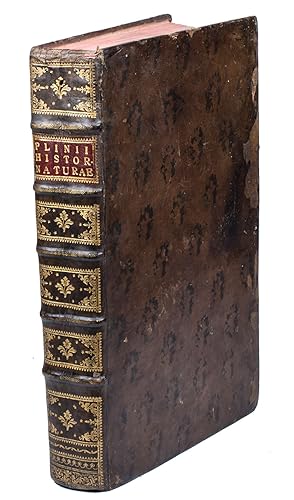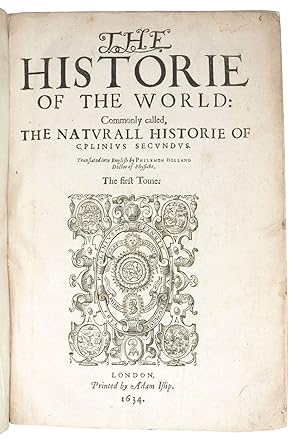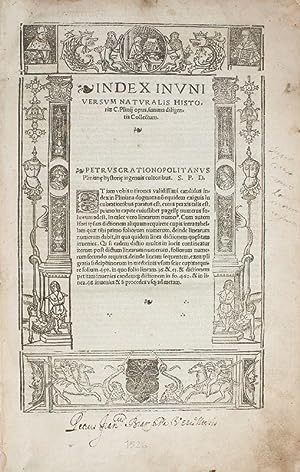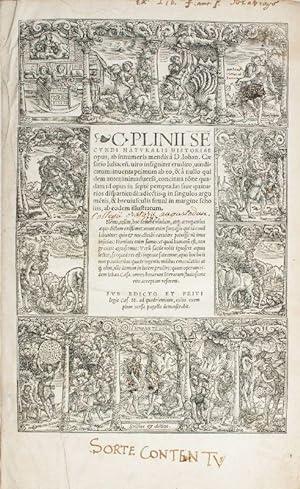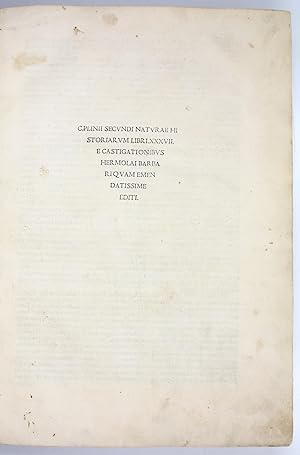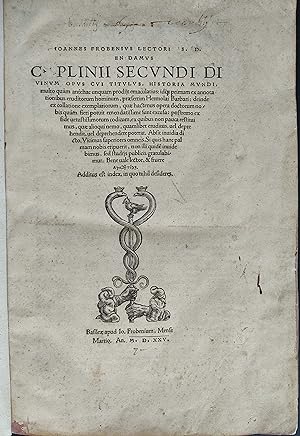plinius secundus gaius pliny elder (9 Ergebnisse)
Produktart
- Alle Produktarten
- Bücher (8)
- Magazine & Zeitschriften
- Comics
- Noten
- Kunst, Grafik & Poster (1)
- Fotografien
- Karten
-
Manuskripte &
Papierantiquitäten
Zustand
- Alle
- Neu
- Antiquarisch/Gebraucht
Einband
- alle Einbände
- Hardcover (5)
- Softcover
Weitere Eigenschaften
- Erstausgabe (3)
- Signiert (1)
- Schutzumschlag
- Angebotsfoto
Land des Verkäufers
Verkäuferbewertung
-
Historiarum naturae libri XXXVII, post omnes omnium editiones, .Paris, Jean Parvum (index: Jean Petit), 1532. Folio. 18th-century cat's paw calf, richly gold-tooled spine.
Anbieter: ASHER Rare Books, T Goy Houten, Niederlande
[36], 671, [188] pp.Praised 1532 edition of Pliny's Naturalis historia: "Cette édition citée avec éloge par Ernesti et par Rezzonico." (Brunet). Pliny's Natural history is one of the largest single works to have survived from the Roman Empire and purports to cover the entire field of ancient knowledge, based on the best authorities available at the time. It encompasses the fields of botany, zoology, astronomy, geology and mineralogy as well as the exploitation of those resources. It remains a standard work for the Roman period and the advances in technology and understanding of natural phenomena at the time. ''We know from Pliny that there were important pearl fisheries in the Gulf Pliny identifies Tylos (Bahrain) as a place famous for its pearls [He] attests that pearls were the most highly rated valuable in Roman society, and that those from the Gulf were specially praised The pearl related finds at the site of El-Dur indicate the site was integrated into the maritime trade routes linking the Roman Empire, the Persian Empire, India and South Arabia'' (Carter).With bookplate on paste-down, some ink notes on the title-page, the first page, and occasionally in the margins; title-page a bit soiled; some wormholes near the end of the book, mostly in the margins. Binding slightly worn along the extremities. Overall in good condition.l Brunet IV, col. 715; Carter, ''The history and prehistory of pearling in the Persian Gulf'', in: Journal of the economic and social history of the orient, 48 (2005), pp.139-209; Graesse V, p. 339 ("Excellente édition"); for Pliny: DSB XI, pp. 38-40.
-
The Historie of the World, commonly called the Naturall Historie.London, Adam Islip, 1634. 2 parts in one volume. Folio (23.5 x 32 cm). Elaborate woodcut device on title-page; woodcut initials, head- and tailpieces. Contemporary calf, spine in six compartments, tooled and lettered in gilt.
Anbieter: Antiquariaat FORUM BV, Houten, Niederlande
(58), 614, (42) pp. (12), 632, (86) pp.Pliny's renowned Natural History in its second publication in English (repeating, with corrections, the 1601 first publication), translated by Philemon Holland, the greatest translator of the Elizabethan age. The "Naturalis Historia" is one of the largest single works to have survived from the Roman empire to the modern day and purports to cover the entire field of ancient knowledge, based on the best authorities available to the author. Pliny claims to be the only Roman ever to have undertaken such a work. It comprised 37 books in 10 volumes and covered over 20,000 facts on topics including the fields of botany, zoology, astronomy , geology and mineralogy as well as the exploitation of those resources. It remains a standard work for the Roman period and the advances in technology and understanding of natural phenomena at the time. Some technical advances he discusses are the only sources for those inventions, such as hushing in mining technology or the use of water mills for crushing or grinding corn. Much of what he wrote about has been confirmed by archaeology. ''We know from Pliny that there were important pearl fisheries in the Gulf [.] Pliny identifies Tylos (Bahrain) as a place famous for its pearls [. He] attests that pearls were the most highly rated valuable in Roman society, and that those from the Gulf were specially praised [.] The pearl related finds at the site of El-Dur indicate the site was integrated into the maritime trade routes linking the Roman Empire, the Persian Empire, India and South Arabia'' (Carter). Book 6 holds a chapter that gives the first detailed account of the regions around the Gulf, including what are now Qatar, the Emirates and Oman. Binding rubbed; front hinge splitting. Includes the final printed leaf in vol. 2, containing the publisher's advertisement to the reader that all errors have been corrected in the present edition and the errata leaf (included in the same position in 1601) has become unnecessary rather than having been mistakenly omitted. Some slight browning and brownstaining, but an excellent copy removed in 1973 from the Royal Meteorological Society (Symons Bequest, 1900) with their bookplate on the front pastedown.l STC 20030. Cf. Pforzheimer 496 (1601 ed.).
-
Opus divinum, cui titulus naturalis historiae, multoquam antehac unquam prodiit in lucem castigatius, una cum annotationibus Hermanolai barbari.
Verlag: Paris, (Nicolaus Savetier) for Jean Petit, 1526., 1526
Anbieter: Antiquariat INLIBRIS Gilhofer Nfg. GmbH, Vienna, A, Österreich
Folio. (188), (34), CCCCCXXXVI [= CCCCCXXXVIII; 538] pp. Title-page in red and black and separate title-page to index, both with woodcut border. Elaborately decorated calf, with image of the crucifixion on both panels. Blind-tooled spine. First and only Paris edition of "Historiae naturalis", with the annotations by Hermolaus Barbarus (1454-94), an Italian Renaissance scholar. His discussions of Pliny's "Naturalis Historia" was first published as "Castigationes Plinianae" in 1492, in which he made over 5000 corrections to the original text. Due to this work and other classical works he translated or edited he was considered a leader authority on Latin and Greek work on antiquity. The present copy was published by Jean Petit, in his days a leading bookseller in Paris, whose name and device are shown on the title-page with decorative woodcut border. The title-page to the index, here bound before the text, has the initials of the printer Nicolaus Sauetier. - The original text was by Gaius Plinius Secundus (AD 23-79), better known as Pliny the Elder. He was a Roman author, naturalist, and natural philosopher, as well as naval and army commander of the early Roman Empire, and personal friend of the emperor Vespasian. - The "Naturalis Historia" is one of the largest single works to have survived from the Roman empire to the modern day and purports to cover the entire field of ancient knowledge, based on the best authorities available to Pliny. He claims to be the only Roman ever to have undertaken such a work. It comprised 37 books in 10 volumes and covered over 20,000 facts on topics including the fields of botany, zoology, astronomy, geology and mineralogy as well as the exploitation of those resources. It remains a standard work for the Roman period and the advances in technology and understanding of natural phenomena at the time. Some technical advances he discusses are the only sources for those inventions, such as hushing in mining technology or the use of water mills for crushing or grinding corn. Much of what he wrote about has been confirmed by archaeology. ''We know from Pliny that there were important pearl fisheries in the Gulf [.] Pliny identifies Tylos (Bahrain) as a place famous for its pearls [. He] attests that pearls were the most highly rated valuable in Roman society, and that those from the Gulf were specially praised [.] The pearl related finds at the site of El-Dur indicate the site was integrated into the maritime trade routes linking the Roman Empire, the Persian Empire, India and South Arabia'' (Carter). Book 6 has a chapter that gives the first detailed account of the regions around the Gulf, including what are now Qatar, the Emirates and Oman. - Not only is it virtually the only work which describes the work of artists of the time, and has it become an important reference work for the history of art, due to the wide range of topics, the referencing system and index it became a model for later encyclopaedias. - Panels shaved, affecting the decoration, spine cracked on the hinges. With manuscript ownership on title-page of the index. A good copy. - Bird 1910. USTC (2 copies). Not in Adams, BMC French, Durling, Hunt, Wellcome.
-
The Historie of the World, commonly called the Naturall Historie.
Verlag: London, Adam Islip, 1601., 1601
Anbieter: Antiquariat INLIBRIS Gilhofer Nfg. GmbH, Vienna, A, Österreich
Folio (32 x 20 cm). 2 vols. in one. (58), 614, (42) pp. (12), 632, (86) pp. Elaborate woodcut device on title-page; woodcut initials, head and tailpieces. 19th century half morocco & marbled boards, spine tooled in blind, lettered in gilt, raised bands. Pliny the Elder's renowned Natural History in its first publication in English, translated by Philemon Holland, the greatest translator of the Elizabethan age. The "Naturalis Historia" is one of the largest single works to have survived from the Roman empire to the modern day and purports to cover the entire field of ancient knowledge, based on the best authorities available to Pliny. He claims to be the only Roman ever to have undertaken such a work. It comprised 37 books in 10 volumes and covered over 20.000 facts on topics including the fields of botany, zoology, astronomy, geology and mineralogy as well as the exploitation of those resources. It remains a standard work for the Roman period and the advances in technology and understanding of natural phenomena at the time. Some technical advances he discusses are the only sources for those inventions, such as hushing in mining technology or the use of water mills for crushing or grinding corn. Much of what he wrote about has been confirmed by archaeology. "We know from Pliny that there were important pearl fisheries in the Gulf [.] Pliny identifies Tylos (Bahrain) as a place famous for its pearls [. He] attests that pearls were the most highly rated valuable in Roman society, and that those from the Gulf were specially praised [.] The pearl related finds at the site of El-Dur indicate the site was integrated into the maritime trade routes linking the Roman Empire, the Persian Empire, India and South Arabia" (Carter). Book 6 holds a chapter that gives the first detailed account of the regions around the Gulf, including what are now Qatar, the Emirates and Oman. - Includes the final printed leaf in vol. 2, containing the errata and printer's colophon. In this copy, the title-page was evidently cut horizontally, above the device, then pieced back together, backed with early laid paper, with the lower half slightly darkened. - STC 20029. Pforzheimer 496.
-
Naturalis historiae opus.
Verlag: (Cologne, Eucharius Cervicornus, 1524)., 1524
Anbieter: Antiquariat INLIBRIS Gilhofer Nfg. GmbH, Vienna, A, Österreich
Erstausgabe
Folio. (16), 311, (60) ff. Title-page and sub-title to index with ornamental woodcut border. Woodcut initials, head and tail pieces. Calf, gold-tooled ribbed spine with title-label. Sprinkled edges. First edition of the "Natural history" edited by Johannes Caesarius (1468-1550), a humanist and close friend of Erasmus. The original text was by Gaius Plinius Secundus (AD 23 - August 25, AD 79), better known as Pliny the Elder. He was a Roman author, naturalist, and natural philosopher, as well as naval and army commander of the early Roman Empire, and personal friend of the emperor Vespasian. The text in the present edition is decorated with woodcut borders and many woodcut initials. - The "Naturalis Historia" is one of the largest single works to have survived from the Roman empire to the modern day and purports to cover the entire field of ancient knowledge, based on the best authorities available to Pliny. He claims to be the only Roman ever to have undertaken such a work. It comprised 37 books in 10 volumes and covered over 20,000 facts on topics including the fields of botany, zoology, astronomy , geology and mineralogy as well as the exploitation of those resources. It remains a standard work for the Roman period and the advances in technology and understanding of natural phenomena at the time. Some technical advances he discusses are the only sources for those inventions, such as hushing in mining technology or the use of water mills for crushing or grinding corn. Much of what he wrote about has been confirmed by archaeology. ''We know from Pliny that there were important pearl fisheries in the Gulf [.] Pliny identifies Tylos (Bahrain) as a place famous for its pearls [. He] attests that pearls were the most highly rated valuable in Roman society, and that those from the Gulf were specially praised [.] The pearl related finds at the site of El-Dur indicate the site was integrated into the maritime trade routes linking the Roman Empire, the Persian Empire, India and South Arabia'' (Carter). Book 6 holds a chapter that gives the first detailed account of the regions around the Gulf, including what are now Qatar, the Emirates and Oman. - Not only is it virtually the only work which describes the work of artists of the time, and has it become an important reference work for the history of art, due to the wide range of topics, the referencing system and index it became a model for later encyclopaedias. - With manuscript notes of multiple owners on pastedown (including written ex-libris by Antonii Mauritii Seguin 1713 and Mathon de la cour 1744). Some underling in text, and notes in the margins (partly lost due to trimmed edges). A very good copy with bookplate of De Ponsainpierre on pastedown. - VD 16, P 3531. Adams P 1556. BM-STC German 704. Durling 3689 (imperfect copy). Hunt 23. USTC (11 copies).
-
Naturae historiarum libri XXXVII. E castigationibus Hermolai Barbari quam emendatissime editi.
Verlag: Venice, Bernardinus Benalius, 1497 (but not before 13 Feb. 1498)., 1498
Anbieter: Antiquariat INLIBRIS Gilhofer Nfg. GmbH, Vienna, A, Österreich
Erstausgabe
Folio. 268 ff. Contemporary vellum with ms. title to spine. Fine incunabular edition of Pliny's famous encylopedic work, covering the entire field of ancient knowledge. With his "Natural History", Pliny gives a mathematical and physical description of the world, discusses geography, ethnography, anthropology, human physiology, zoology, botany, mineralogy, sculpture and painting. As "a purveyor of information both scientific and nonscientific, Pliny holds a place of exceptional importance in the tradition and diffusion of culture" (DSB). Through the present work Pliny "gives us by far the most detailed account of the coast of the United Arab Emirates that has come down to us. Chapter 32 of Book 6 (§ 149-152), beginning near the Qatar peninsula, proceeds to describe the Emirates islands, tribes, and coast right up to the Musandam peninsula, before continuing on south along the coast of Oman. As such, it is a mine of invaluable information on the UAE in the late pre-Islamic era" (UAE History, online). Pliny "completed his 'Natural History' in 77 AD and, to judge from his account of the peoples and places of south-eastern Arabia [.], the area of the UAE was full of settlements, tribes, and physical features, the names of which he recorded for posterity" (Ghareeb/Al Abed 54). - "This appears to be the first edition of Barbarus' recension, the note of a 1496 edition by the same printer being probably due to a confusion (Hain 13099)" (BMC). Dated 1497 in the colophon, but the dedication is dated the Ides of February in the twelfth year of the Doge Augustinus Barbadicus (30 Aug. 1497 to 29 Aug. 1498). - Numerous contemporary marginalia. Slight worming to gutter and some waterstaining near end; spine restored. Late 19th-c. bookplate of Dr. J. Klauber on front pastedown. - HC 13101*. Goff P-799. GW M34321. Klebs 786.14. Proctor 4893A. BMC V 377. ISTC ip00799000.
-
Plinius und die Zahnmedizin. Textstellen der Naturalis Historia.
Erscheinungsdatum: 1964
Anbieter: Antiq. F.-D. Söhn - Medicusbooks.Com, Marburg, Deutschland
Buch
Kölner Med. Beitr., 67. - Hrsg. v. Marielene Putscher. - Köln 1994, 8°, (8), 363, (5) pp., orig. kartonierter Einband. Erstdruck! Mit einem Aufsatz von Vivian Nutton "Wissen, Erfahrung, Magie" und einer Einleitung von P. Schulz und M. Putscher.
-
Historiae Naturalis Libri XXXVII.
Verlag: Lugduni Batavorum Leiden: ex officina Elzeviriana, 1635
Anbieter: Unsworth's Antiquarian Booksellers, ILAB, ABA, PBFA., London, Vereinigtes Königreich
Kunst / Grafik / Poster Erstausgabe Signiert
First edition thus. 3 vols., 12mo, pp. [xxiv], 654, [xviii]; 631, [xvii]; 582, [xviii]. Engraved titlepage, small woodcut portrait of Pliny. With 'variae lectiones' and indexes at end of each vol. Slight toning, occasional minor spots, titles dusty, 1: one lower outer blank corner minimally torn, 2: small loss to lower blank margin of one leaf. Full blue morocco c.1800, signed by C. Hering (binder's ticket), blind-tooled, straight-grained calf doublures with gilt edges, raised bands, spines gilt-lettered, a.e.g. (boards and joints rubbed, free endpapers soiled). Later annotation to original rear endpaper. The first Elzevier edition of Pliny's 'Natural History', which became extremely popular with later collectors. De Laet was a Leiden historian and editor who wrote or produced a number of texts for the Elzevir press. In the dedication, to the lawyer and French royal counsellor Jerome Bignon (1589-1656), he states that he drew on the edition of Claude Saumaise. Willems 428; Dibdin (3rd edn.) II, 323.
-
En damus C. Plinii Secundi divinum opus cui titulus, Historia mundi.
Verlag: Johannes Froben, Basel, 1525
Anbieter: Rodger Friedman Rare Book Studio, ABAA, Tuxedo, NY, USA
Zustand: Very Good. Folio (37 cm); [18] leaves, 671, [143] pages. Woodcut printer's device, the double-headed caduceus designed by Holbein, on title page, on verso of p. 671, on the title page of the index, and on the final page. Holbein's detailed chiaroscuro woodcut initials throughout. Bound in vellum over boards, titled in manuscript on spine. Old jottings in manuscript on upper board (apparently an Italian and Latin vocabulary list including the names of foodstuffs). Portion of vellum near head of spine replaced. Erasmus's name on running head of dedicatory letter aggressively inked over! Occasional scattered very light foxing in a generally bright and unblemished text. References; Adams P-1560; van der Haeghen, Biblioteca Erasmiana, p. 45. For the initials (among Holbein's largest), see Schneeli and Heitz, table V #II, and table LXXXIII, #XL. Erasmus's edition of Pliny's Natural History, conserving the notes from Ermolao Barbaro's edition of 1492, printed by Johannes Froben at the height of his powers. Froben's title page is effectively a billboard: "We give you the work of the Divine Pliny called History of the World, more immaculate than any edition ever produced before, starting with the annotations of erudite men, first among them Ermolao Barbaro, and then exemplary contributions by learned people which are still worth correcting, with faith in the oldest codices, from which we have restored many faults, so difficult to find that no one, no matter how learned, could find them or had found them before. We have nothing to envy [in any previous edition]. We have defeated all of our elders. And if someone now takes this prize from us, we will not envy them, but we will be grateful for the improvement of public education. Go, reader, and be fruitful. And, by the way, we added an index that lacks for nothing.".


